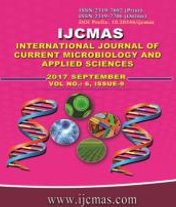


 National Academy of Agricultural Sciences (NAAS)
National Academy of Agricultural Sciences (NAAS)

|
PRINT ISSN : 2319-7692
Online ISSN : 2319-7706 Issues : 12 per year Publisher : Excellent Publishers Email : editorijcmas@gmail.com / submit@ijcmas.com Editor-in-chief: Dr.M.Prakash Index Copernicus ICV 2018: 95.39 NAAS RATING 2020: 5.38 |
Human immunodeficiency virus (HIV) is responsible for depletion of CD4 cell count. Thus resulting in the rise of opportunistic infections (OI) leading to increase in morbidity and mortality in HIV infected patients. The aim of the study was to observe the opportunistic infections and CD4 count in HIV/AIDS patients. The work was done in Microbiology, Al-Ameen Medical College Vijayapur, Karnataka from January 2012 – December 2012. The relevant investigations were carried out along with CD4 count. Among total 1254 HIV patients it was seen males had increase preponderance than females. Heterosexual route been commonest mode of transmission. Common opportunistic infections were pulmonary tuberculosis 44.66%, Candidiasis 23.92%, Cryptosporidial diarrhea 19.46%, Herpes zoster 3.19%, Cryptococcal meningitis 2.80%, Pneumocystis jiroveci pneumonia 1.99% and other miscellaneous infections 3.98%. CD4count in 41.70% was between 201-500/µl followed by 29.10% between 101-200/µl. The present study demonstrates the profile of opportunistic infections and CD4 count in HIV/AIDS patients.
 |
 |
 |
 |
 |